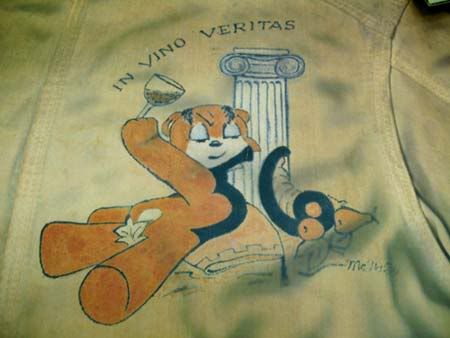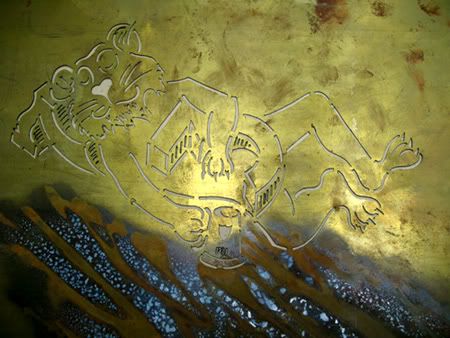 Starting today, the Prox will be running a weekly segment featuring some of the awesome things to be found in the Seeley G. Mudd Manuscript Library, where the University Archives are housed. You'd be surprised what you can find there — but all things in good time.
Starting today, the Prox will be running a weekly segment featuring some of the awesome things to be found in the Seeley G. Mudd Manuscript Library, where the University Archives are housed. You'd be surprised what you can find there — but all things in good time. Right now seniors are done voting on beer jacket designs, and I thought it might be nice to look at designs from years past. The Mudd actually has the metal stencils used to create these beer jackets and they're all comfortably housed in a single archival box; I should add that it's a heavy box.
Images and commentary after the jump.
The beer jacket tradition dates to the early 20th century, although originally they were apparently full beer suits. You can find a more complete history of the Princeton beer jacket here.
 The first logo design that really caught my attention was from 1945. In 1945, the Second World War finally ended. It was probably clear to most Princeton students by the spring of 1945 that the War would soon be over, but that also means that the War had had ample time to destroy that generation’s innocence. You’ll notice that the “45” is shattered. In the foreground is a decorated Tiger, riffle in hand, whose expression is either determined or terrified. His shadow is clearly a student, not a soldier, and like the year, it’s broken.
The first logo design that really caught my attention was from 1945. In 1945, the Second World War finally ended. It was probably clear to most Princeton students by the spring of 1945 that the War would soon be over, but that also means that the War had had ample time to destroy that generation’s innocence. You’ll notice that the “45” is shattered. In the foreground is a decorated Tiger, riffle in hand, whose expression is either determined or terrified. His shadow is clearly a student, not a soldier, and like the year, it’s broken. On the other hand, it seems 1948 was finally a good year. The numbers are as they should be, and the Tiger is dressed elegantly for a celebratory night out—there’s an unmistakable look of hope on his face and the weapons of war lie discarded in the background, a receding memory.
On the other hand, it seems 1948 was finally a good year. The numbers are as they should be, and the Tiger is dressed elegantly for a celebratory night out—there’s an unmistakable look of hope on his face and the weapons of war lie discarded in the background, a receding memory. And then of course, there’s the 1960s. Look at the logo from 1960—the Tiger looks contented and well fed, you could almost call his expression one of beatitude. And of course, there’s the case, reminiscent not only of the music which defined that decade, but also of the female form. Of course, not as reminiscent of the female form as some of the other logos from that decade, like the one from ’62, which is definitely erotic.
And then of course, there’s the 1960s. Look at the logo from 1960—the Tiger looks contented and well fed, you could almost call his expression one of beatitude. And of course, there’s the case, reminiscent not only of the music which defined that decade, but also of the female form. Of course, not as reminiscent of the female form as some of the other logos from that decade, like the one from ’62, which is definitely erotic.
 1963 brings us a happy echo of the Cold War and the Space Race. Even in space, apparently, Tigers need their booze. Well, I guess there aren’t any girls made out of numbers in space… Incidentally, there have been Princetonian astronauts—the Princeton flag has been to the Moon and back, but that’s a story for another time.
1963 brings us a happy echo of the Cold War and the Space Race. Even in space, apparently, Tigers need their booze. Well, I guess there aren’t any girls made out of numbers in space… Incidentally, there have been Princetonian astronauts—the Princeton flag has been to the Moon and back, but that’s a story for another time.That’s it for this issue. I leave you with a photograph of the 1956 jacket, so that you can get an idea of what these looked like in COLOR. The Princetoniana site has a few more designs. Of course, if you’re really interested, you can always head up to the Mudd—and don’t forget: the Blue Line and Green Line stop right around there.

All images are courtesy of the Seeley G. Mudd Manuscript Library. Any other use of these images requires written permission from the archive.





4 comments:
You should look at the Class of 1941. Their logo includes the world as a bomb on a short fuse, that happens to look like Hitler, and those students soon swapped books for weapons.
The logos during the war years are particularly telling. For most other years, the theme frequently included booze, women, and partying. Nothing wrong with that, but those classes who lived in the shadow of war reflect a history that is hard to comprehend or fully appreciate.
Thanks for sharing some of Mudd's treasures with a wider audience. Students please note: Mudd only has these images through the generosity of alumni. Many of those here came through the generosity of the late Hugh "Bud" Wynne, Class of 1939. So if you have more recent images, please contact me!
Dan Linke
University Archivist
mudd@princeton.edu
Thanks for the great post on our beer jacket collection, Martha. Looking forward to future posts about moon flags and such.
Christie Lutz
Assistant University Archivist
The 'beer jacket' fad must have drifted down to pre college, as I recall owning one in 1939, my high school senior year. The idea was to have everyone in class sign or write a note on it like your year book1
Post a Comment